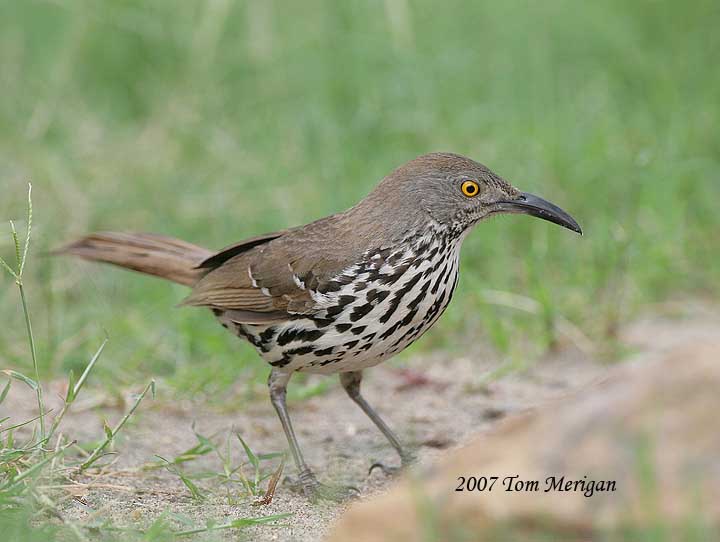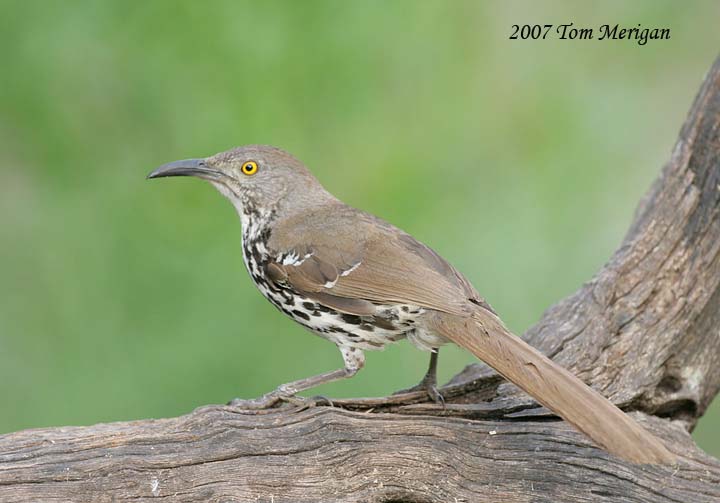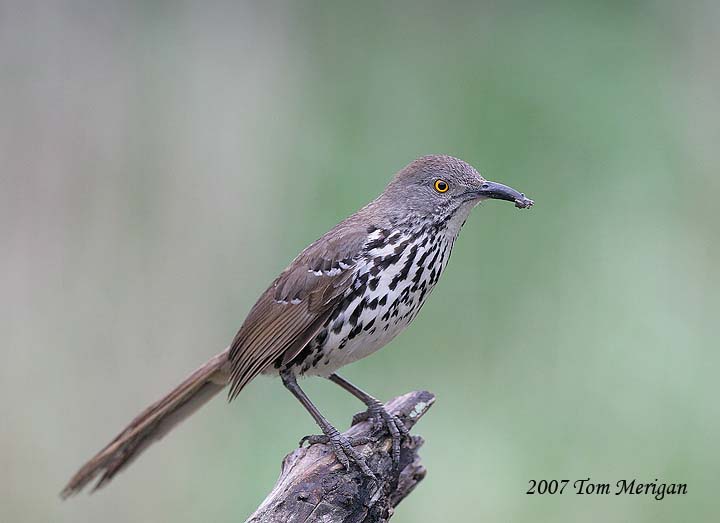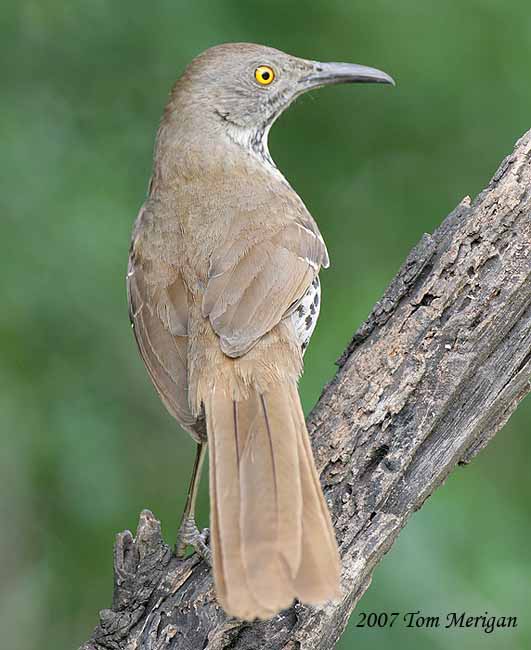
Long-billed Thrasher
Toxostoma longirostre
Passeriforme Order – Mimidae Family
BIOMETRICS:
Length: 26-29 cm
Wingspan: 33 cm
Weight: 38 gr
LONGEVITY: up to 7 years
DESCRIPTION:
Long-billed Thrasher is a medium-sized bird. It has greyish-brown upperparts and two conspicuous white wing bars. Underparts are whitish, heavily streaked with black. Long fan-shaped tail is dark brown. Vent is buff.
Head shows grey crown and forehead. Nape is rather brownish-grey, joining with brown back. Chin and throat are white, bordered by dark malar stripe.
Long down curved bill is grey, with pale pinkish-grey base on lower mandible. Eyes are orange to orange-yellow. Legs and feet are brown.

Both sexes are similar.
Juvenile resembles adults, but with duller plumage, indistinct spots on head, buff wing bars and pale eyes, rather yellow.
Similar species:
Brown Thrasher (Toxostoma rufum), is more reddish and browner with shorter bill.
Curve-billed Thrasher (Toxostoma curvirostre), is greyer, without conspicuous dark streaks on underparts, and with longer curved bill.
Sage Thrasher (Oreoscoptes montanus), is greyer with shorter bill and conspicuous white tips on rectrices. It winters in the range of Long-billed Thrasher.
Ocellated Thrasher (Toxostoma ocellatum) lives in Central Mexico, but it doesn’t overlap with Long-billed Thrasher range.
VOICE: SOUNDS BY XENO-CANTO
Long-billed Thrasher’s song includes rich various phrases repeated twice or three times. Call includes a “tsuck” like Brown Thrasher, a mellow descending “kleak”, and a loud ascending “cheeooep”.
HABITAT:
Long-billed Thrasher lives in dense scrubby thickets, especially dense mesquite, and woodland edges along streams.
RANGE:
Long-billed Thrasher is resident in its range, from southern Texas and through eastern Mexico.

BEHAVIOUR:
Long-billed Thrasher forages on the ground, sweeping its bill from side to side in leaf-litter. It tosses litter upwards and behind with its bill, and scratches with its feet for food. It runs quickly on the ground while searching for food.
Long-billed Thrasher is monogamous and solitary nester. Males utter harsh calls in territorial disputes. It frequently sings from and exposed perch. Male is aggressive to other species when some intruder enters its territory. It defends its nest site vigorously, as against birds or humans.
FLIGHT:
Long-billed Thrasher performs a fast flight with shallow wing beats. When flying on short distances, it performs several rapid wing beats alternated with periods with closed wings on body sides. Flights generally are short and close to the ground.

REPRODUCTION:
Long-billed Thrasher’s nest is a bulky cup made with twigs, rootlets, straw and coarse woody stems. Interior is lined with fine roots, bark and moss. Nest is usually hidden in a dense thorny bush or in a low tree, at about 4 to 8 feet above the ground.
Female lays 4 to 5 pale blue eggs, finely spotted with brown. Incubation lasts about 13 to 14 days, shared by both parents. Altricial chicks hatch over a period of at least 24 hours. They are fed by both adults, first on invertebrates, and then, on some vegetable matter. Young fledge at about 12 to 14 days.
This species may produce two broods per year.

DIET:
Long-billed Thrasher feeds mainly on invertebrates, such as grasshoppers, beetles and spiders. It also consumes some snails and slugs, and berries.
PROTECTION / THREATS / STATUS:
Long-billed Thrasher is common in suitable habitat. But habitat loss, with clearing of brushland for extending cultivated areas, caused a major decline in Rio Grande Valley between 1930s and 1970s. At this time, about 95% of brushland was destroyed.
However, human activities, with invasion of former grasslands by scrubs, may be better for this species. Long-billed Thrasher may extend its range westwards.
Fr: Moqueur à long bec
All: Langschnabel-Spottdrossel
Esp : Cuitlacoche de Pico Largo
Ital : Mimo beccolungo
Nd : Langsnavelspotlijster
Sd: Långnäbbad härmtrast
Photographs by Tom Merigan
His website:
Tom Meriganís Photo Galleries
Text by Nicole Bouglouan
Sources:
FIELD GUIDE TO THE BIRDS OF NORTH AMERICA by National Geographic Society - National Geographic Society - ISBN: 0792274512
All About Birds (Cornell Lab of Ornithology)
What Bird-The ultimate Bird Guide (Mitchell Waite)
Wikipedia (Wikipedia, The Free Encyclopedia)